Holmes Institute HI6006 Competitive Strategy Essay - T2 2019
VerifiedAdded on 2022/10/02
|11
|2097
|276
Essay
AI Summary
This essay provides an in-depth analysis of key strategy development tools, focusing on their application in business contexts. The essay begins with an introduction to strategy development, emphasizing its importance in aligning actions and allocating resources. It then delves into three core models: the Resource Based View (RBV), Generic Strategies, and the Ansoff Matrix. The RBV model is explained as a means of achieving superior firm performance by leveraging valuable, rare, costly-to-imitate, and organized resources (VRIO). Generic Strategies, as proposed by Michael Porter, are examined, including cost leadership, differentiation leadership, cost focus, and differentiation focus. Finally, the Ansoff Matrix is presented as a tool for analyzing growth strategies, with a discussion of market penetration, product development, market development, and diversification. The essay concludes by reiterating the importance of strategic tools in navigating competitive landscapes and achieving business objectives. The essay is prepared for the HI6006 Competitive Strategy course at Holmes Institute.
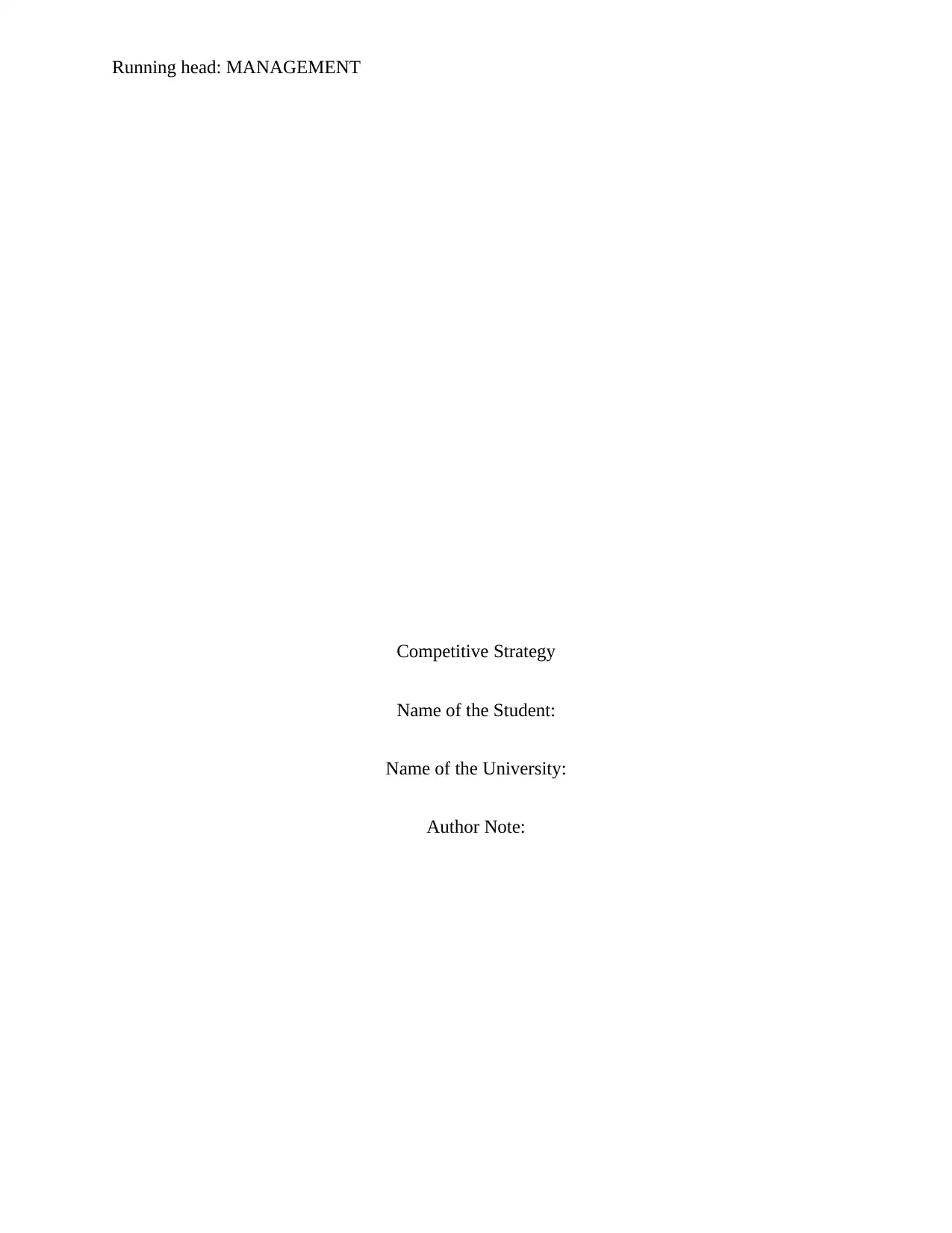
Running head: MANAGEMENT
Competitive Strategy
Name of the Student:
Name of the University:
Author Note:
Competitive Strategy
Name of the Student:
Name of the University:
Author Note:
Paraphrase This Document
Need a fresh take? Get an instant paraphrase of this document with our AI Paraphraser
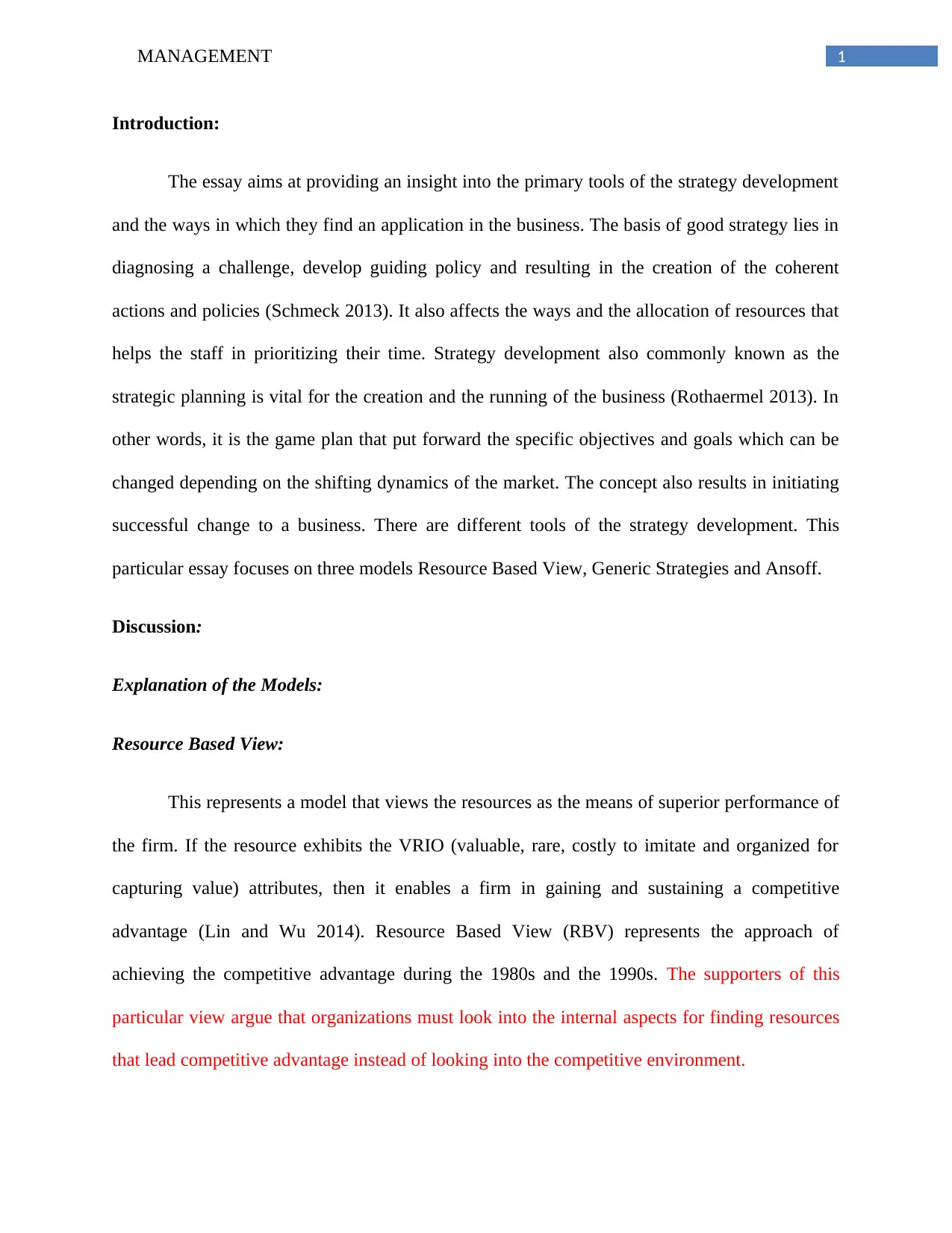
1MANAGEMENT
Introduction:
The essay aims at providing an insight into the primary tools of the strategy development
and the ways in which they find an application in the business. The basis of good strategy lies in
diagnosing a challenge, develop guiding policy and resulting in the creation of the coherent
actions and policies (Schmeck 2013). It also affects the ways and the allocation of resources that
helps the staff in prioritizing their time. Strategy development also commonly known as the
strategic planning is vital for the creation and the running of the business (Rothaermel 2013). In
other words, it is the game plan that put forward the specific objectives and goals which can be
changed depending on the shifting dynamics of the market. The concept also results in initiating
successful change to a business. There are different tools of the strategy development. This
particular essay focuses on three models Resource Based View, Generic Strategies and Ansoff.
Discussion:
Explanation of the Models:
Resource Based View:
This represents a model that views the resources as the means of superior performance of
the firm. If the resource exhibits the VRIO (valuable, rare, costly to imitate and organized for
capturing value) attributes, then it enables a firm in gaining and sustaining a competitive
advantage (Lin and Wu 2014). Resource Based View (RBV) represents the approach of
achieving the competitive advantage during the 1980s and the 1990s. The supporters of this
particular view argue that organizations must look into the internal aspects for finding resources
that lead competitive advantage instead of looking into the competitive environment.
Introduction:
The essay aims at providing an insight into the primary tools of the strategy development
and the ways in which they find an application in the business. The basis of good strategy lies in
diagnosing a challenge, develop guiding policy and resulting in the creation of the coherent
actions and policies (Schmeck 2013). It also affects the ways and the allocation of resources that
helps the staff in prioritizing their time. Strategy development also commonly known as the
strategic planning is vital for the creation and the running of the business (Rothaermel 2013). In
other words, it is the game plan that put forward the specific objectives and goals which can be
changed depending on the shifting dynamics of the market. The concept also results in initiating
successful change to a business. There are different tools of the strategy development. This
particular essay focuses on three models Resource Based View, Generic Strategies and Ansoff.
Discussion:
Explanation of the Models:
Resource Based View:
This represents a model that views the resources as the means of superior performance of
the firm. If the resource exhibits the VRIO (valuable, rare, costly to imitate and organized for
capturing value) attributes, then it enables a firm in gaining and sustaining a competitive
advantage (Lin and Wu 2014). Resource Based View (RBV) represents the approach of
achieving the competitive advantage during the 1980s and the 1990s. The supporters of this
particular view argue that organizations must look into the internal aspects for finding resources
that lead competitive advantage instead of looking into the competitive environment.
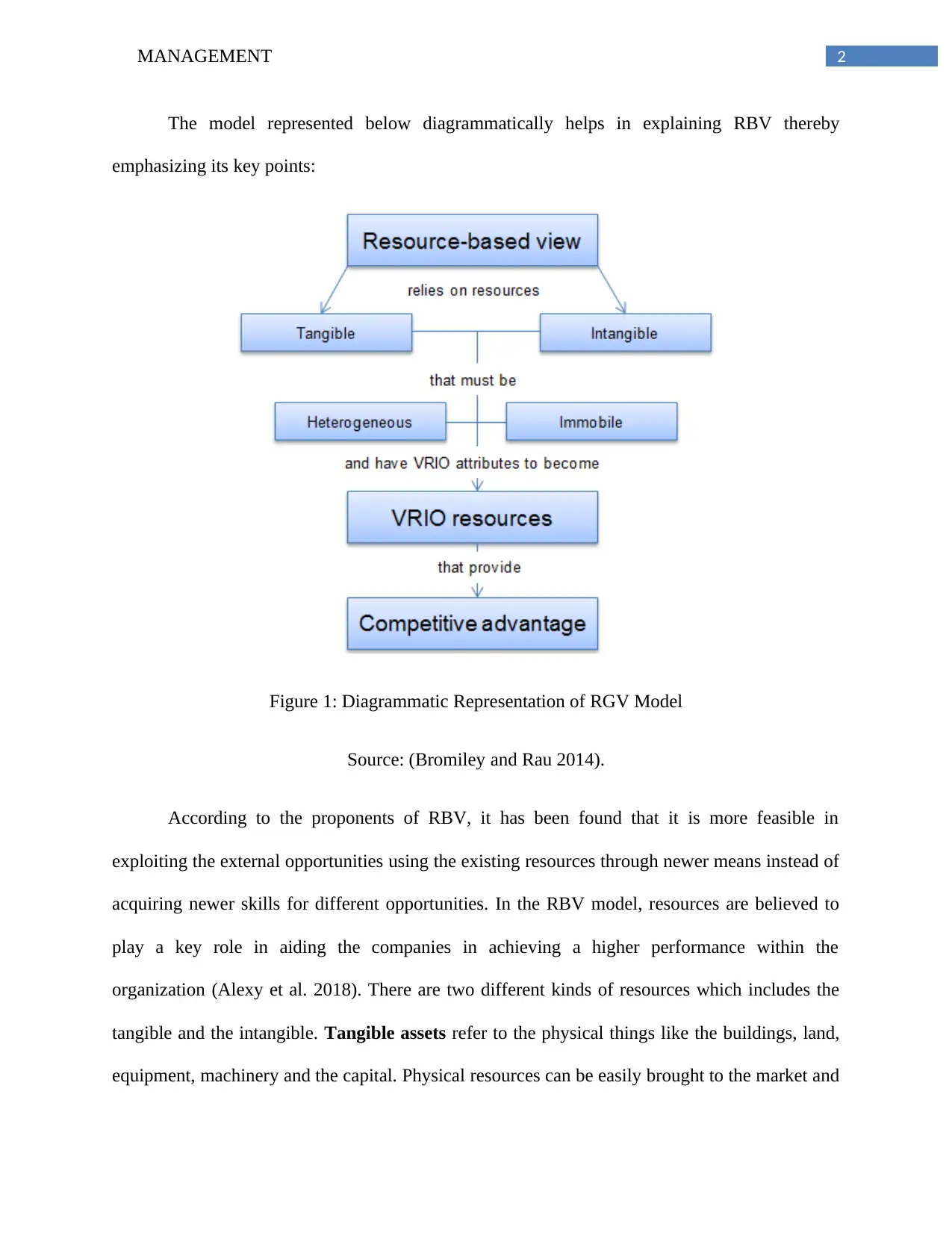
2MANAGEMENT
The model represented below diagrammatically helps in explaining RBV thereby
emphasizing its key points:
Figure 1: Diagrammatic Representation of RGV Model
Source: (Bromiley and Rau 2014).
According to the proponents of RBV, it has been found that it is more feasible in
exploiting the external opportunities using the existing resources through newer means instead of
acquiring newer skills for different opportunities. In the RBV model, resources are believed to
play a key role in aiding the companies in achieving a higher performance within the
organization (Alexy et al. 2018). There are two different kinds of resources which includes the
tangible and the intangible. Tangible assets refer to the physical things like the buildings, land,
equipment, machinery and the capital. Physical resources can be easily brought to the market and
The model represented below diagrammatically helps in explaining RBV thereby
emphasizing its key points:
Figure 1: Diagrammatic Representation of RGV Model
Source: (Bromiley and Rau 2014).
According to the proponents of RBV, it has been found that it is more feasible in
exploiting the external opportunities using the existing resources through newer means instead of
acquiring newer skills for different opportunities. In the RBV model, resources are believed to
play a key role in aiding the companies in achieving a higher performance within the
organization (Alexy et al. 2018). There are two different kinds of resources which includes the
tangible and the intangible. Tangible assets refer to the physical things like the buildings, land,
equipment, machinery and the capital. Physical resources can be easily brought to the market and
⊘ This is a preview!⊘
Do you want full access?
Subscribe today to unlock all pages.

Trusted by 1+ million students worldwide
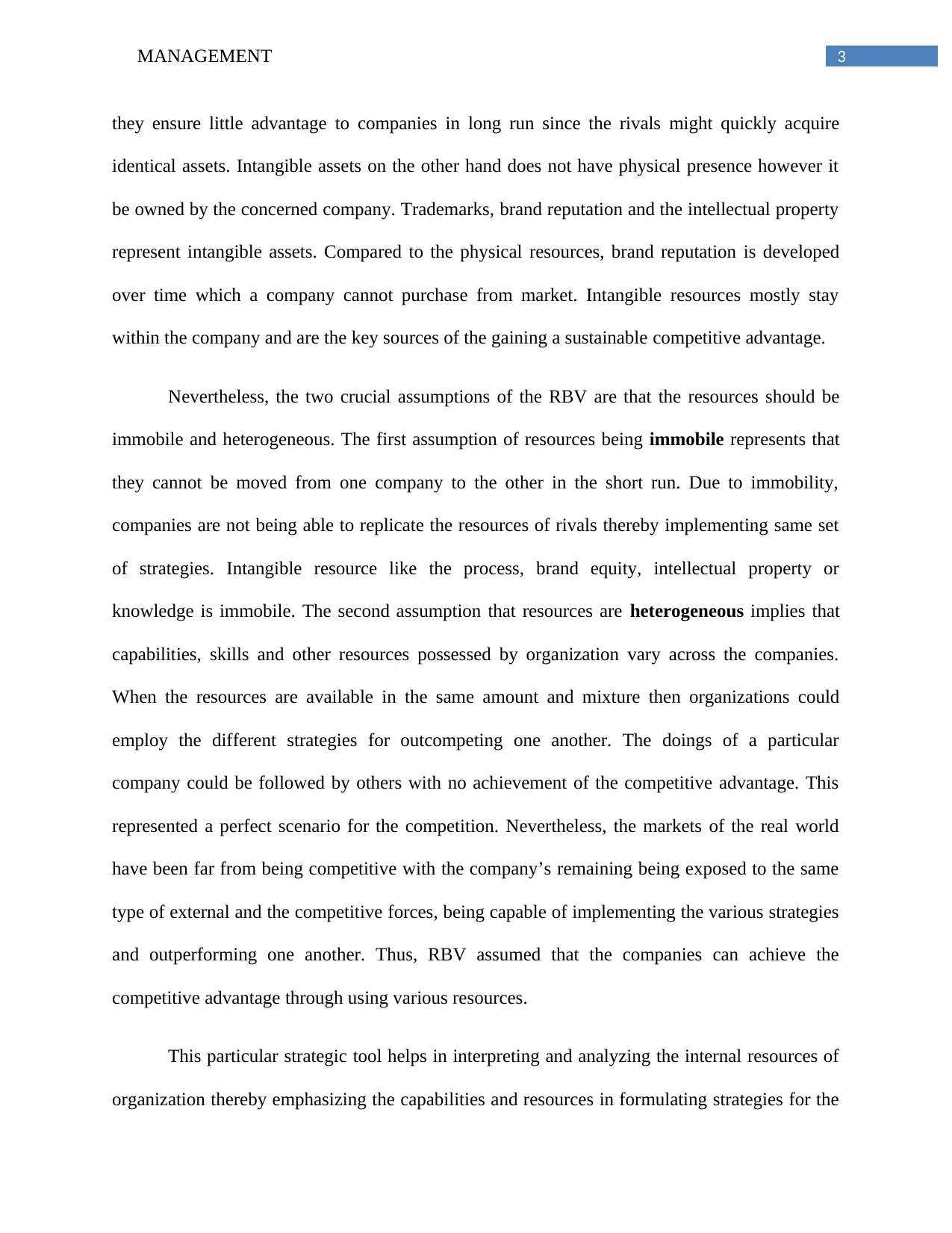
3MANAGEMENT
they ensure little advantage to companies in long run since the rivals might quickly acquire
identical assets. Intangible assets on the other hand does not have physical presence however it
be owned by the concerned company. Trademarks, brand reputation and the intellectual property
represent intangible assets. Compared to the physical resources, brand reputation is developed
over time which a company cannot purchase from market. Intangible resources mostly stay
within the company and are the key sources of the gaining a sustainable competitive advantage.
Nevertheless, the two crucial assumptions of the RBV are that the resources should be
immobile and heterogeneous. The first assumption of resources being immobile represents that
they cannot be moved from one company to the other in the short run. Due to immobility,
companies are not being able to replicate the resources of rivals thereby implementing same set
of strategies. Intangible resource like the process, brand equity, intellectual property or
knowledge is immobile. The second assumption that resources are heterogeneous implies that
capabilities, skills and other resources possessed by organization vary across the companies.
When the resources are available in the same amount and mixture then organizations could
employ the different strategies for outcompeting one another. The doings of a particular
company could be followed by others with no achievement of the competitive advantage. This
represented a perfect scenario for the competition. Nevertheless, the markets of the real world
have been far from being competitive with the company’s remaining being exposed to the same
type of external and the competitive forces, being capable of implementing the various strategies
and outperforming one another. Thus, RBV assumed that the companies can achieve the
competitive advantage through using various resources.
This particular strategic tool helps in interpreting and analyzing the internal resources of
organization thereby emphasizing the capabilities and resources in formulating strategies for the
they ensure little advantage to companies in long run since the rivals might quickly acquire
identical assets. Intangible assets on the other hand does not have physical presence however it
be owned by the concerned company. Trademarks, brand reputation and the intellectual property
represent intangible assets. Compared to the physical resources, brand reputation is developed
over time which a company cannot purchase from market. Intangible resources mostly stay
within the company and are the key sources of the gaining a sustainable competitive advantage.
Nevertheless, the two crucial assumptions of the RBV are that the resources should be
immobile and heterogeneous. The first assumption of resources being immobile represents that
they cannot be moved from one company to the other in the short run. Due to immobility,
companies are not being able to replicate the resources of rivals thereby implementing same set
of strategies. Intangible resource like the process, brand equity, intellectual property or
knowledge is immobile. The second assumption that resources are heterogeneous implies that
capabilities, skills and other resources possessed by organization vary across the companies.
When the resources are available in the same amount and mixture then organizations could
employ the different strategies for outcompeting one another. The doings of a particular
company could be followed by others with no achievement of the competitive advantage. This
represented a perfect scenario for the competition. Nevertheless, the markets of the real world
have been far from being competitive with the company’s remaining being exposed to the same
type of external and the competitive forces, being capable of implementing the various strategies
and outperforming one another. Thus, RBV assumed that the companies can achieve the
competitive advantage through using various resources.
This particular strategic tool helps in interpreting and analyzing the internal resources of
organization thereby emphasizing the capabilities and resources in formulating strategies for the
Paraphrase This Document
Need a fresh take? Get an instant paraphrase of this document with our AI Paraphraser
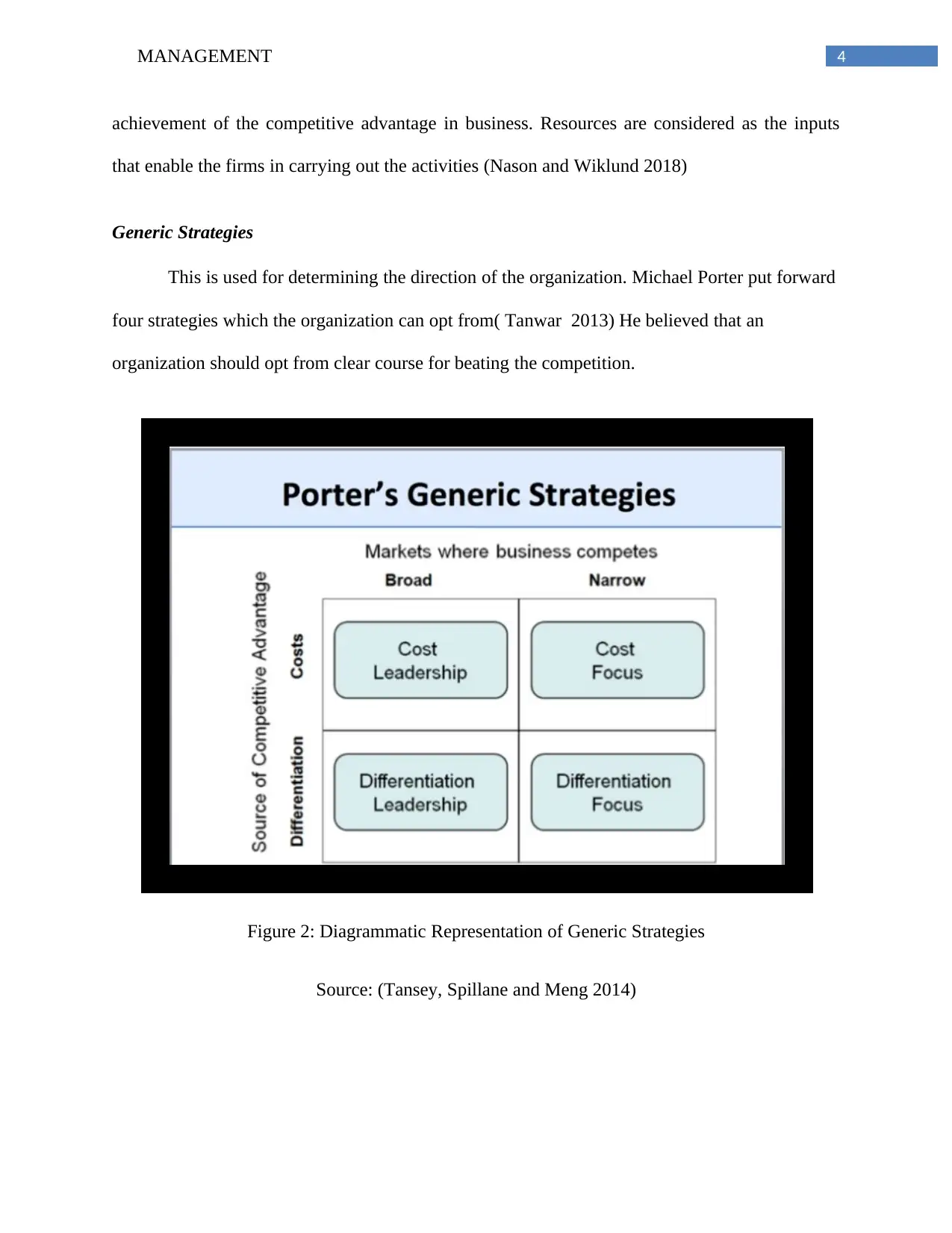
4MANAGEMENT
achievement of the competitive advantage in business. Resources are considered as the inputs
that enable the firms in carrying out the activities (Nason and Wiklund 2018)
Generic Strategies
This is used for determining the direction of the organization. Michael Porter put forward
four strategies which the organization can opt from( Tanwar 2013) He believed that an
organization should opt from clear course for beating the competition.
Figure 2: Diagrammatic Representation of Generic Strategies
Source: (Tansey, Spillane and Meng 2014)
achievement of the competitive advantage in business. Resources are considered as the inputs
that enable the firms in carrying out the activities (Nason and Wiklund 2018)
Generic Strategies
This is used for determining the direction of the organization. Michael Porter put forward
four strategies which the organization can opt from( Tanwar 2013) He believed that an
organization should opt from clear course for beating the competition.
Figure 2: Diagrammatic Representation of Generic Strategies
Source: (Tansey, Spillane and Meng 2014)
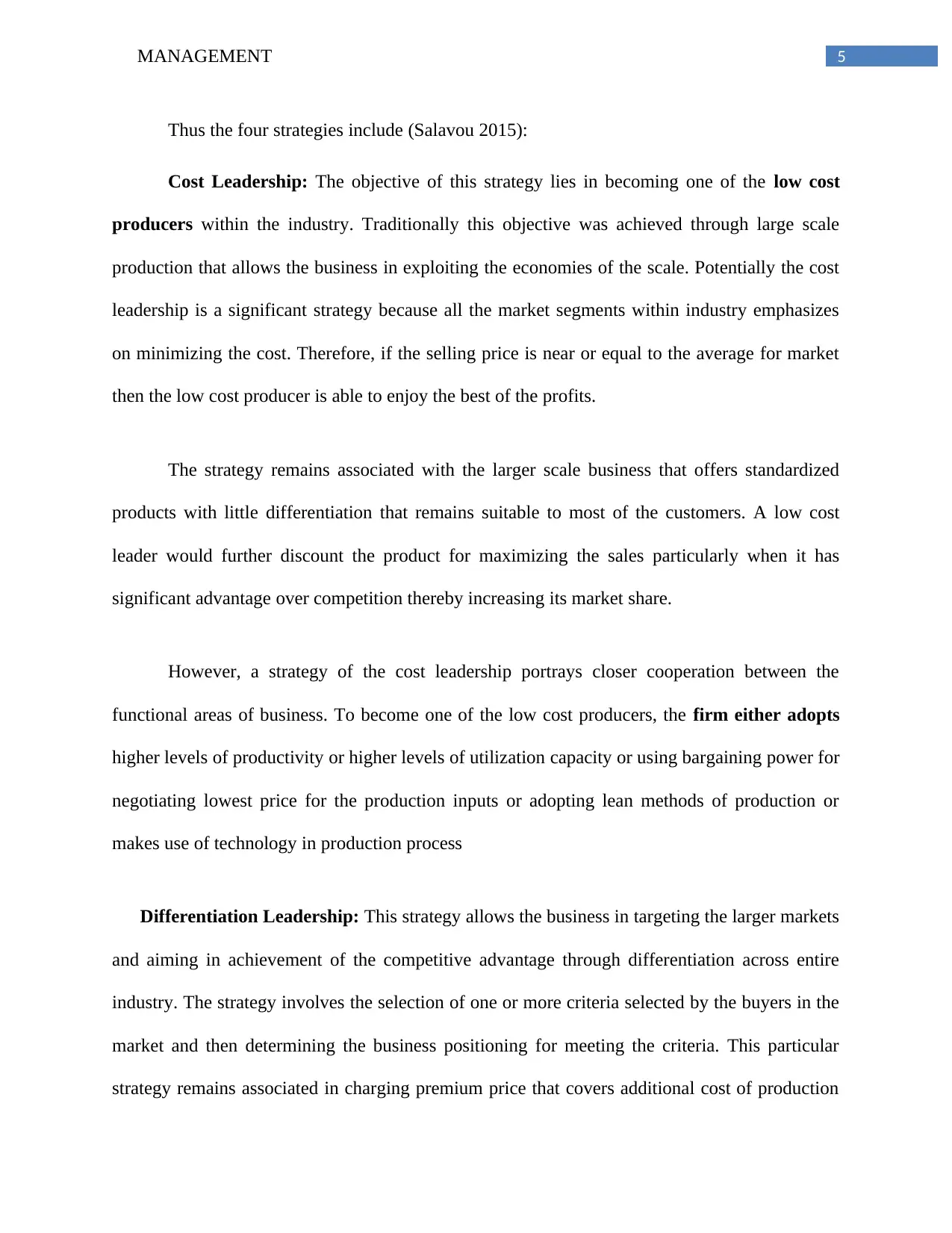
5MANAGEMENT
Thus the four strategies include (Salavou 2015):
Cost Leadership: The objective of this strategy lies in becoming one of the low cost
producers within the industry. Traditionally this objective was achieved through large scale
production that allows the business in exploiting the economies of the scale. Potentially the cost
leadership is a significant strategy because all the market segments within industry emphasizes
on minimizing the cost. Therefore, if the selling price is near or equal to the average for market
then the low cost producer is able to enjoy the best of the profits.
The strategy remains associated with the larger scale business that offers standardized
products with little differentiation that remains suitable to most of the customers. A low cost
leader would further discount the product for maximizing the sales particularly when it has
significant advantage over competition thereby increasing its market share.
However, a strategy of the cost leadership portrays closer cooperation between the
functional areas of business. To become one of the low cost producers, the firm either adopts
higher levels of productivity or higher levels of utilization capacity or using bargaining power for
negotiating lowest price for the production inputs or adopting lean methods of production or
makes use of technology in production process
Differentiation Leadership: This strategy allows the business in targeting the larger markets
and aiming in achievement of the competitive advantage through differentiation across entire
industry. The strategy involves the selection of one or more criteria selected by the buyers in the
market and then determining the business positioning for meeting the criteria. This particular
strategy remains associated in charging premium price that covers additional cost of production
Thus the four strategies include (Salavou 2015):
Cost Leadership: The objective of this strategy lies in becoming one of the low cost
producers within the industry. Traditionally this objective was achieved through large scale
production that allows the business in exploiting the economies of the scale. Potentially the cost
leadership is a significant strategy because all the market segments within industry emphasizes
on minimizing the cost. Therefore, if the selling price is near or equal to the average for market
then the low cost producer is able to enjoy the best of the profits.
The strategy remains associated with the larger scale business that offers standardized
products with little differentiation that remains suitable to most of the customers. A low cost
leader would further discount the product for maximizing the sales particularly when it has
significant advantage over competition thereby increasing its market share.
However, a strategy of the cost leadership portrays closer cooperation between the
functional areas of business. To become one of the low cost producers, the firm either adopts
higher levels of productivity or higher levels of utilization capacity or using bargaining power for
negotiating lowest price for the production inputs or adopting lean methods of production or
makes use of technology in production process
Differentiation Leadership: This strategy allows the business in targeting the larger markets
and aiming in achievement of the competitive advantage through differentiation across entire
industry. The strategy involves the selection of one or more criteria selected by the buyers in the
market and then determining the business positioning for meeting the criteria. This particular
strategy remains associated in charging premium price that covers additional cost of production
⊘ This is a preview!⊘
Do you want full access?
Subscribe today to unlock all pages.

Trusted by 1+ million students worldwide
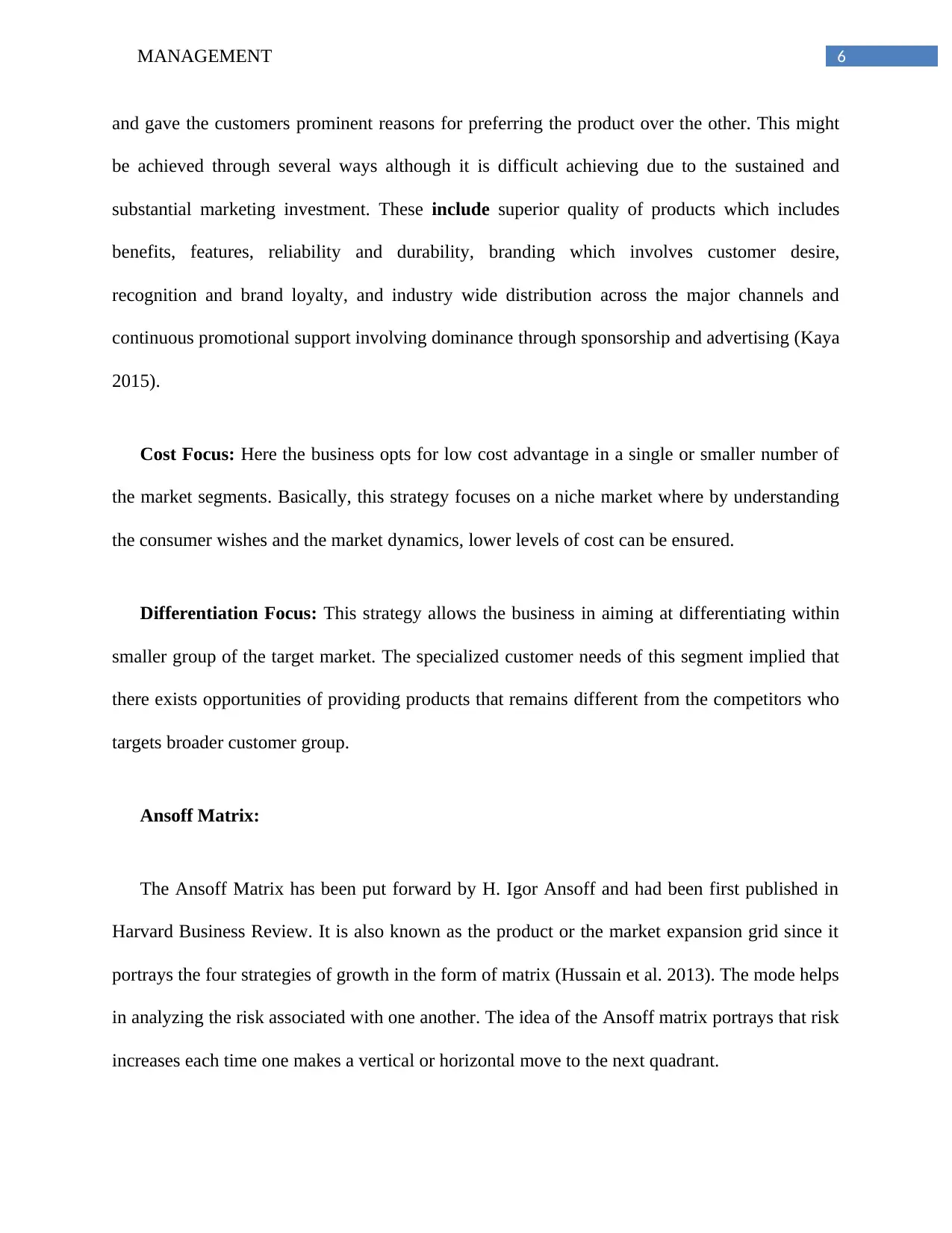
6MANAGEMENT
and gave the customers prominent reasons for preferring the product over the other. This might
be achieved through several ways although it is difficult achieving due to the sustained and
substantial marketing investment. These include superior quality of products which includes
benefits, features, reliability and durability, branding which involves customer desire,
recognition and brand loyalty, and industry wide distribution across the major channels and
continuous promotional support involving dominance through sponsorship and advertising (Kaya
2015).
Cost Focus: Here the business opts for low cost advantage in a single or smaller number of
the market segments. Basically, this strategy focuses on a niche market where by understanding
the consumer wishes and the market dynamics, lower levels of cost can be ensured.
Differentiation Focus: This strategy allows the business in aiming at differentiating within
smaller group of the target market. The specialized customer needs of this segment implied that
there exists opportunities of providing products that remains different from the competitors who
targets broader customer group.
Ansoff Matrix:
The Ansoff Matrix has been put forward by H. Igor Ansoff and had been first published in
Harvard Business Review. It is also known as the product or the market expansion grid since it
portrays the four strategies of growth in the form of matrix (Hussain et al. 2013). The mode helps
in analyzing the risk associated with one another. The idea of the Ansoff matrix portrays that risk
increases each time one makes a vertical or horizontal move to the next quadrant.
and gave the customers prominent reasons for preferring the product over the other. This might
be achieved through several ways although it is difficult achieving due to the sustained and
substantial marketing investment. These include superior quality of products which includes
benefits, features, reliability and durability, branding which involves customer desire,
recognition and brand loyalty, and industry wide distribution across the major channels and
continuous promotional support involving dominance through sponsorship and advertising (Kaya
2015).
Cost Focus: Here the business opts for low cost advantage in a single or smaller number of
the market segments. Basically, this strategy focuses on a niche market where by understanding
the consumer wishes and the market dynamics, lower levels of cost can be ensured.
Differentiation Focus: This strategy allows the business in aiming at differentiating within
smaller group of the target market. The specialized customer needs of this segment implied that
there exists opportunities of providing products that remains different from the competitors who
targets broader customer group.
Ansoff Matrix:
The Ansoff Matrix has been put forward by H. Igor Ansoff and had been first published in
Harvard Business Review. It is also known as the product or the market expansion grid since it
portrays the four strategies of growth in the form of matrix (Hussain et al. 2013). The mode helps
in analyzing the risk associated with one another. The idea of the Ansoff matrix portrays that risk
increases each time one makes a vertical or horizontal move to the next quadrant.
Paraphrase This Document
Need a fresh take? Get an instant paraphrase of this document with our AI Paraphraser
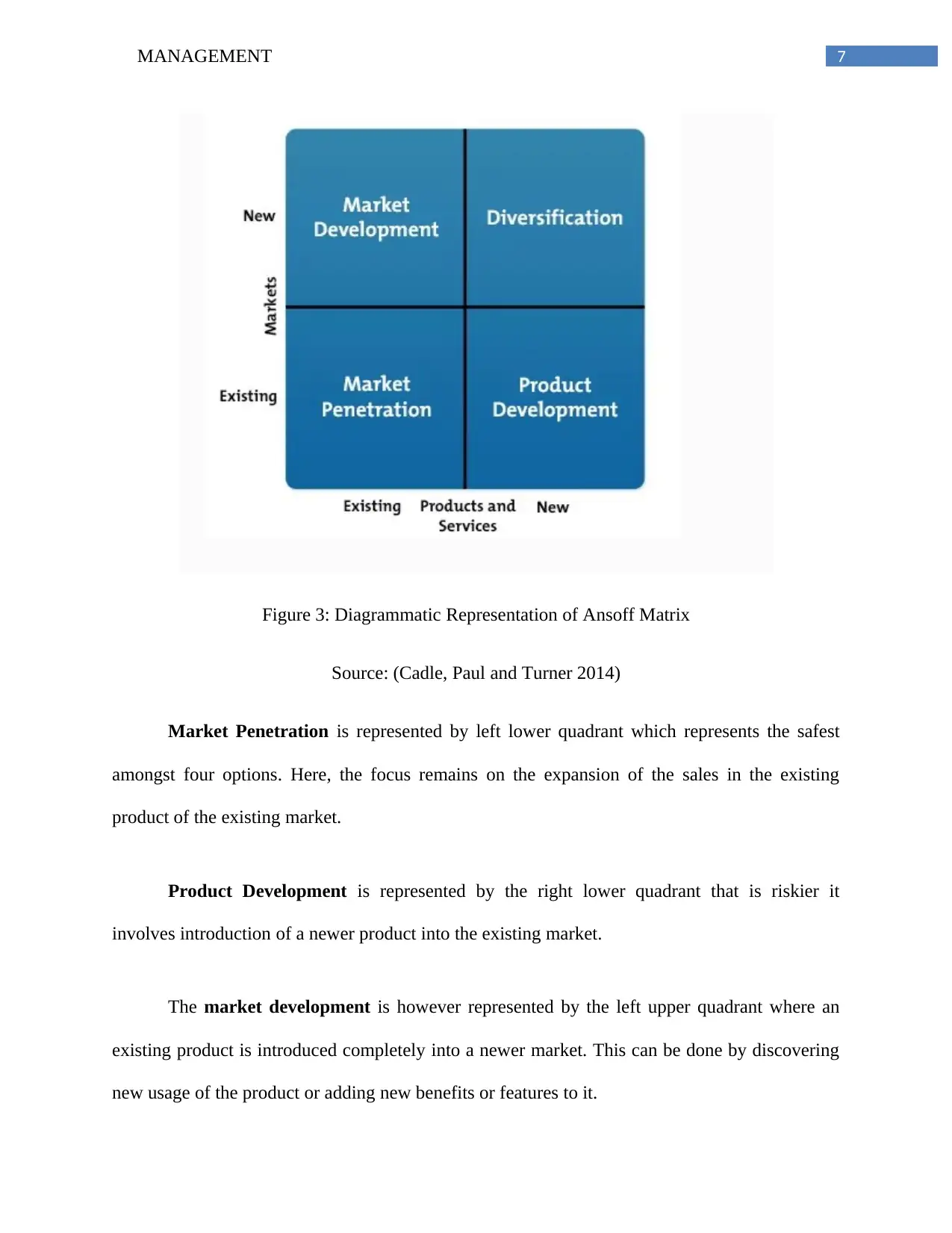
7MANAGEMENT
Figure 3: Diagrammatic Representation of Ansoff Matrix
Source: (Cadle, Paul and Turner 2014)
Market Penetration is represented by left lower quadrant which represents the safest
amongst four options. Here, the focus remains on the expansion of the sales in the existing
product of the existing market.
Product Development is represented by the right lower quadrant that is riskier it
involves introduction of a newer product into the existing market.
The market development is however represented by the left upper quadrant where an
existing product is introduced completely into a newer market. This can be done by discovering
new usage of the product or adding new benefits or features to it.
Figure 3: Diagrammatic Representation of Ansoff Matrix
Source: (Cadle, Paul and Turner 2014)
Market Penetration is represented by left lower quadrant which represents the safest
amongst four options. Here, the focus remains on the expansion of the sales in the existing
product of the existing market.
Product Development is represented by the right lower quadrant that is riskier it
involves introduction of a newer product into the existing market.
The market development is however represented by the left upper quadrant where an
existing product is introduced completely into a newer market. This can be done by discovering
new usage of the product or adding new benefits or features to it.
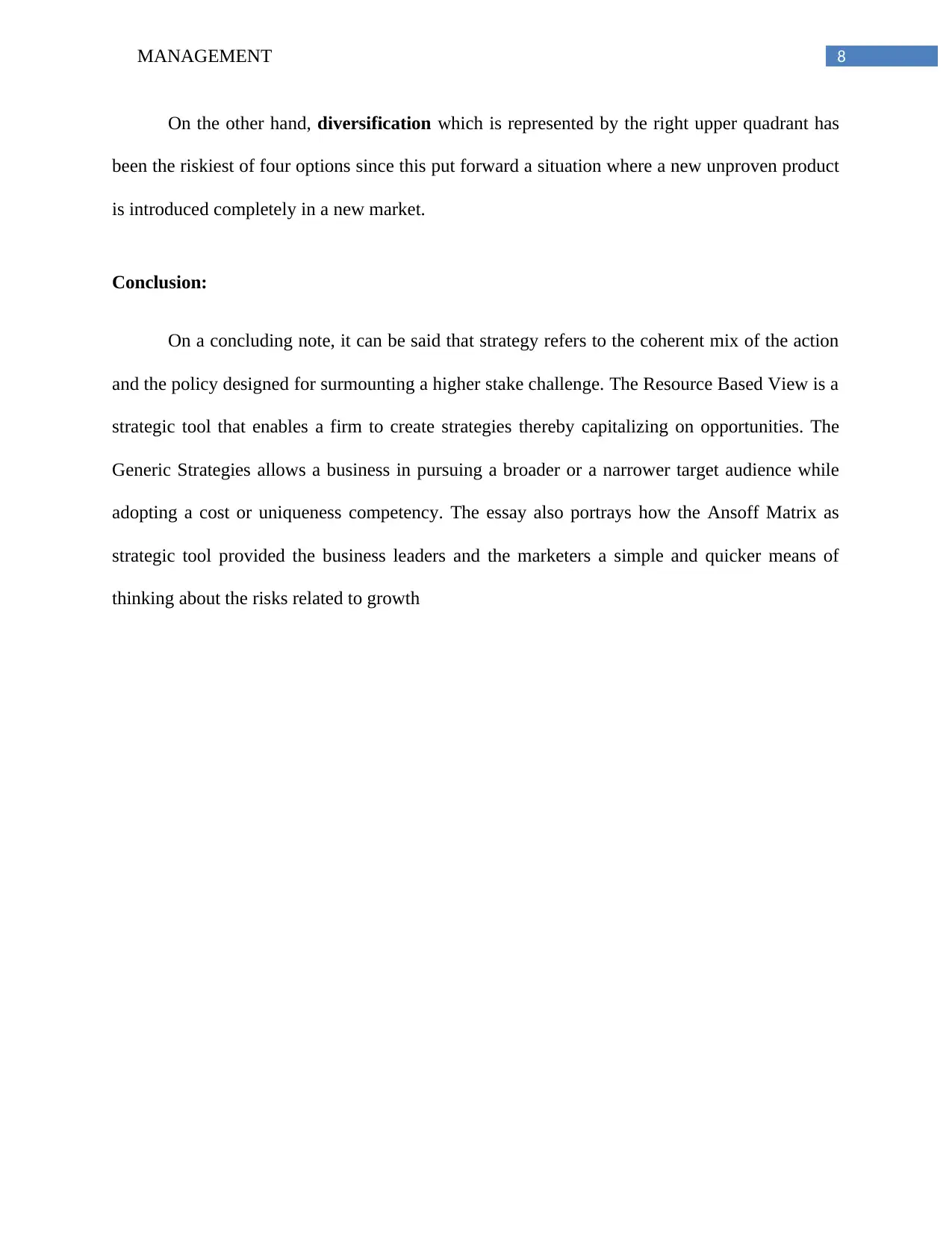
8MANAGEMENT
On the other hand, diversification which is represented by the right upper quadrant has
been the riskiest of four options since this put forward a situation where a new unproven product
is introduced completely in a new market.
Conclusion:
On a concluding note, it can be said that strategy refers to the coherent mix of the action
and the policy designed for surmounting a higher stake challenge. The Resource Based View is a
strategic tool that enables a firm to create strategies thereby capitalizing on opportunities. The
Generic Strategies allows a business in pursuing a broader or a narrower target audience while
adopting a cost or uniqueness competency. The essay also portrays how the Ansoff Matrix as
strategic tool provided the business leaders and the marketers a simple and quicker means of
thinking about the risks related to growth
On the other hand, diversification which is represented by the right upper quadrant has
been the riskiest of four options since this put forward a situation where a new unproven product
is introduced completely in a new market.
Conclusion:
On a concluding note, it can be said that strategy refers to the coherent mix of the action
and the policy designed for surmounting a higher stake challenge. The Resource Based View is a
strategic tool that enables a firm to create strategies thereby capitalizing on opportunities. The
Generic Strategies allows a business in pursuing a broader or a narrower target audience while
adopting a cost or uniqueness competency. The essay also portrays how the Ansoff Matrix as
strategic tool provided the business leaders and the marketers a simple and quicker means of
thinking about the risks related to growth
⊘ This is a preview!⊘
Do you want full access?
Subscribe today to unlock all pages.

Trusted by 1+ million students worldwide
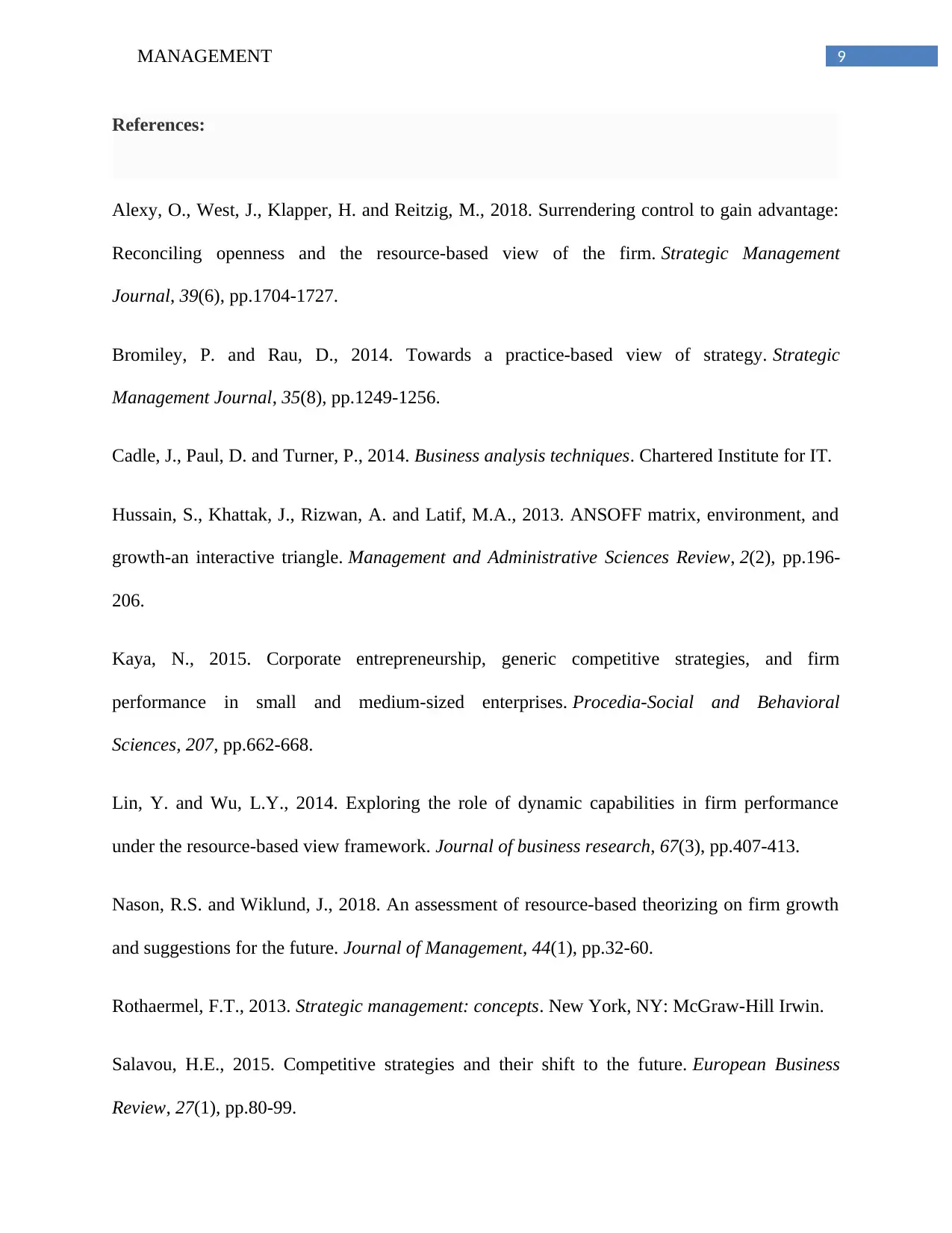
9MANAGEMENT
References:
Alexy, O., West, J., Klapper, H. and Reitzig, M., 2018. Surrendering control to gain advantage:
Reconciling openness and the resource‐based view of the firm. Strategic Management
Journal, 39(6), pp.1704-1727.
Bromiley, P. and Rau, D., 2014. Towards a practice‐based view of strategy. Strategic
Management Journal, 35(8), pp.1249-1256.
Cadle, J., Paul, D. and Turner, P., 2014. Business analysis techniques. Chartered Institute for IT.
Hussain, S., Khattak, J., Rizwan, A. and Latif, M.A., 2013. ANSOFF matrix, environment, and
growth-an interactive triangle. Management and Administrative Sciences Review, 2(2), pp.196-
206.
Kaya, N., 2015. Corporate entrepreneurship, generic competitive strategies, and firm
performance in small and medium-sized enterprises. Procedia-Social and Behavioral
Sciences, 207, pp.662-668.
Lin, Y. and Wu, L.Y., 2014. Exploring the role of dynamic capabilities in firm performance
under the resource-based view framework. Journal of business research, 67(3), pp.407-413.
Nason, R.S. and Wiklund, J., 2018. An assessment of resource-based theorizing on firm growth
and suggestions for the future. Journal of Management, 44(1), pp.32-60.
Rothaermel, F.T., 2013. Strategic management: concepts. New York, NY: McGraw-Hill Irwin.
Salavou, H.E., 2015. Competitive strategies and their shift to the future. European Business
Review, 27(1), pp.80-99.
References:
Alexy, O., West, J., Klapper, H. and Reitzig, M., 2018. Surrendering control to gain advantage:
Reconciling openness and the resource‐based view of the firm. Strategic Management
Journal, 39(6), pp.1704-1727.
Bromiley, P. and Rau, D., 2014. Towards a practice‐based view of strategy. Strategic
Management Journal, 35(8), pp.1249-1256.
Cadle, J., Paul, D. and Turner, P., 2014. Business analysis techniques. Chartered Institute for IT.
Hussain, S., Khattak, J., Rizwan, A. and Latif, M.A., 2013. ANSOFF matrix, environment, and
growth-an interactive triangle. Management and Administrative Sciences Review, 2(2), pp.196-
206.
Kaya, N., 2015. Corporate entrepreneurship, generic competitive strategies, and firm
performance in small and medium-sized enterprises. Procedia-Social and Behavioral
Sciences, 207, pp.662-668.
Lin, Y. and Wu, L.Y., 2014. Exploring the role of dynamic capabilities in firm performance
under the resource-based view framework. Journal of business research, 67(3), pp.407-413.
Nason, R.S. and Wiklund, J., 2018. An assessment of resource-based theorizing on firm growth
and suggestions for the future. Journal of Management, 44(1), pp.32-60.
Rothaermel, F.T., 2013. Strategic management: concepts. New York, NY: McGraw-Hill Irwin.
Salavou, H.E., 2015. Competitive strategies and their shift to the future. European Business
Review, 27(1), pp.80-99.
Paraphrase This Document
Need a fresh take? Get an instant paraphrase of this document with our AI Paraphraser
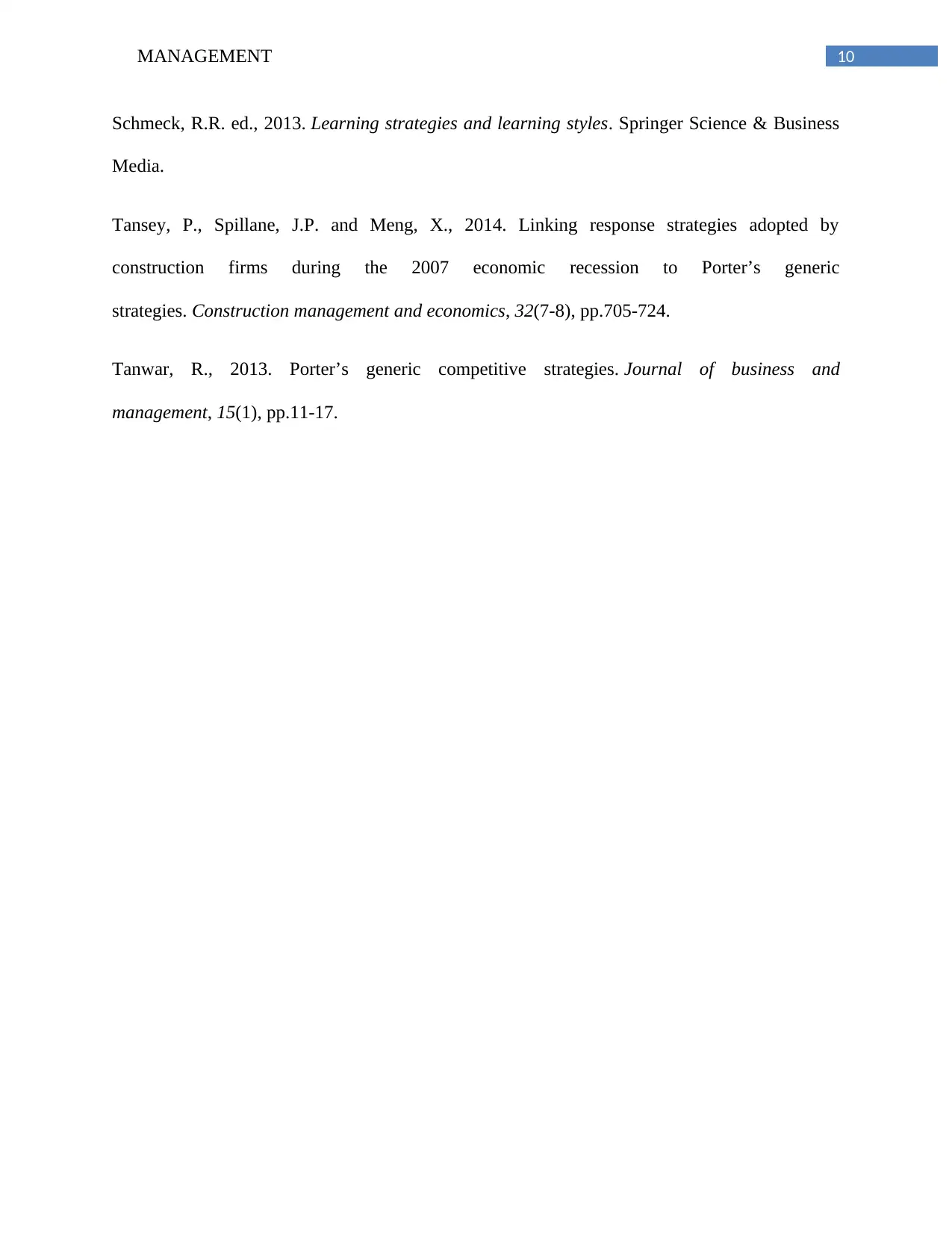
10MANAGEMENT
Schmeck, R.R. ed., 2013. Learning strategies and learning styles. Springer Science & Business
Media.
Tansey, P., Spillane, J.P. and Meng, X., 2014. Linking response strategies adopted by
construction firms during the 2007 economic recession to Porter’s generic
strategies. Construction management and economics, 32(7-8), pp.705-724.
Tanwar, R., 2013. Porter’s generic competitive strategies. Journal of business and
management, 15(1), pp.11-17.
Schmeck, R.R. ed., 2013. Learning strategies and learning styles. Springer Science & Business
Media.
Tansey, P., Spillane, J.P. and Meng, X., 2014. Linking response strategies adopted by
construction firms during the 2007 economic recession to Porter’s generic
strategies. Construction management and economics, 32(7-8), pp.705-724.
Tanwar, R., 2013. Porter’s generic competitive strategies. Journal of business and
management, 15(1), pp.11-17.
1 out of 11
Related Documents
Your All-in-One AI-Powered Toolkit for Academic Success.
+13062052269
info@desklib.com
Available 24*7 on WhatsApp / Email
![[object Object]](/_next/static/media/star-bottom.7253800d.svg)
Unlock your academic potential
Copyright © 2020–2025 A2Z Services. All Rights Reserved. Developed and managed by ZUCOL.





